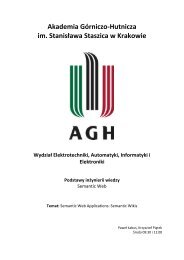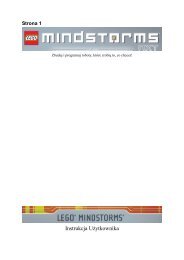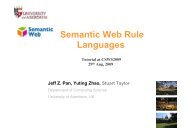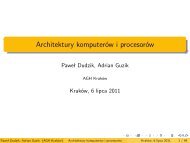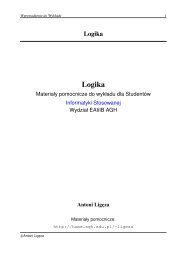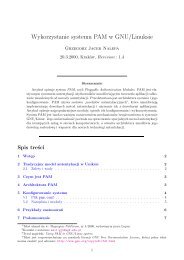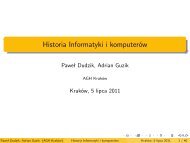An Evaluation of Knowledge Base Systems for Large OWL Datasets
An Evaluation of Knowledge Base Systems for Large OWL Datasets
An Evaluation of Knowledge Base Systems for Large OWL Datasets
You also want an ePaper? Increase the reach of your titles
YUMPU automatically turns print PDFs into web optimized ePapers that Google loves.
In addition to the language change, there are some other differences between the<br />
ontology’s <strong>OWL</strong> version and DAML+OIL version. First, we have used more RDFS<br />
vocabulary in the <strong>OWL</strong> ontology, e.g., rdfs:domain and rdfs:range in replace <strong>of</strong><br />
daml:domain and daml:range respectively. Secondly, we have made some domain<br />
constraint changes to allow emphasis on description logic subsumption. For example,<br />
we have removed the domain constraint (to the class Student) <strong>of</strong> the property takesCourse<br />
so that no individuals <strong>of</strong> GradudateStudent in the benchmark data can be inferred<br />
as an instance <strong>of</strong> Student without the inference <strong>of</strong> the subsumption relationship<br />
between both classes.<br />
2.2 Data Generation and <strong>OWL</strong> <strong>Datasets</strong><br />
LUBM’s test data are extensional data created over the Univ-Bench ontology. In<br />
LUBM, we have adopted a method <strong>of</strong> synthetic data generation. This serves multiple<br />
purposes. As with the Wisconsin benchmark [3, 4], a standard and widely used database<br />
benchmark, this allows us to control the selectivity and output size <strong>of</strong> each test<br />
query. However, there are some other specific considerations:<br />
1) We would like the benchmark data to be <strong>of</strong> a range <strong>of</strong> sizes including considerably<br />
large ones. It is hard to find such data sources that are based on the same ontology.<br />
2) We may need the presence <strong>of</strong> certain kinds <strong>of</strong> instances in the benchmark data.<br />
This allows us to design repeatable tests <strong>for</strong> as many representative query types as<br />
possible. These tests not only evaluate the storage mechanisms <strong>for</strong> Semantic Web<br />
data but also the techniques that exploit <strong>for</strong>mal semantics. We may rely on instances<br />
<strong>of</strong> certain classes and/or properties to test against those techniques.<br />
Data generation is carried out by the Univ-Bench artificial data generator (UBA), a<br />
tool we have developed <strong>for</strong> the benchmark. In the tool, we have implemented the support<br />
<strong>for</strong> <strong>OWL</strong> datasets. The generator features random and repeatable data generation.<br />
A university is the minimum unit <strong>of</strong> data generation and <strong>for</strong> each university, a set <strong>of</strong><br />
<strong>OWL</strong> files describing its departments are generated. Instances <strong>of</strong> both classes and<br />
properties are randomly decided. To make the data as realistic as possible, some restrictions<br />
are applied based on common sense and domain investigation. Examples are<br />
“a minimum <strong>of</strong> 15 and a maximum <strong>of</strong> 25 departments in each university”, “an undergraduate<br />
student/faculty ratio between 8 and 14 inclusively”, “each graduate student<br />
takes at least 1 but at most 3 courses”, and so on and so <strong>for</strong>th. A detailed pr<strong>of</strong>ile <strong>of</strong> the<br />
data generated by the tool can be found on the benchmark’s webpage.<br />
The generator identifies universities by assigning them zero-based indexes, e.g., the<br />
first university is named University0, and so on. Data generated by the tool are exactly<br />
repeatable in respect <strong>of</strong> universities. This is possible because the tool allows the user<br />
to enter an initial seed <strong>for</strong> the random number generator that is used in the data generation<br />
process. Through the tool, we may specify how many and which universities to<br />
generate.<br />
Finally, as with the Univ-Bench ontology, the <strong>OWL</strong> data created by the generator<br />
are also in the <strong>OWL</strong> Lite sublanguage. As a consequence, we have had to give every




